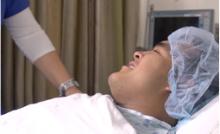While most hemorrhoids do not require surgery, some more severe cases do. Surgery should be considered if a patient’s hemorrhoids have not responded to other nonsurgical treatments. There are two different types of hemorrhoids, external and internal. External hemorrhoids are hemorrhoids that grow outside the body, while internal hemorrhoids grow inside. Patients who suffer from internal hemorrhoids may not know that they suffer from the condition.
Common symptoms of hemorrhoids are blood on toilet paper or in bowel movements, pain, itching, discomfort, and swelling. A number of potential surgical treatments exist for hemorrhoids. These include:
- Banding – a procedure in which a tiny band is put around the hemorrhoid to deprive the hemorrhoid of blood
- Hemorrhoidectomy – a procedure in which an ellipse of skin is cut out over the hemorrhoid and sewn up
- Stapled Hemorrhoidectomy (PPH) – a procedure in which a ring of tissue above the hemorrhoid is cut out and stapled together
To learn more about hemorrhoid treatment and hemorrhoidectomy recovery, contact the Hemorrhoid Surgery Center of Excellence today.
Recovery from Hemorrhoid Surgery
After hemorrhoid surgery patients will be transported to postoperative care where they will be monitored until they are stable and ready to go home. Because hemorrhoidectomy surgery is an outpatient procedure, patients will be free to go home the same day. Hemorrhoidectomy recovery often takes six to eight weeks before patients are completely healed. Many patients return to work in ten days or less. For the first ten days or so patients may experience some pain at the sight of the surgery. Ice can be used to reduce swelling. A bath of warm water can help alleviate discomfort. Patients should be careful to avoid constipation and heavy lifting while undergoing hemorrhoidectomy recovery.
Next, read more about hemorrhoid surgery.










